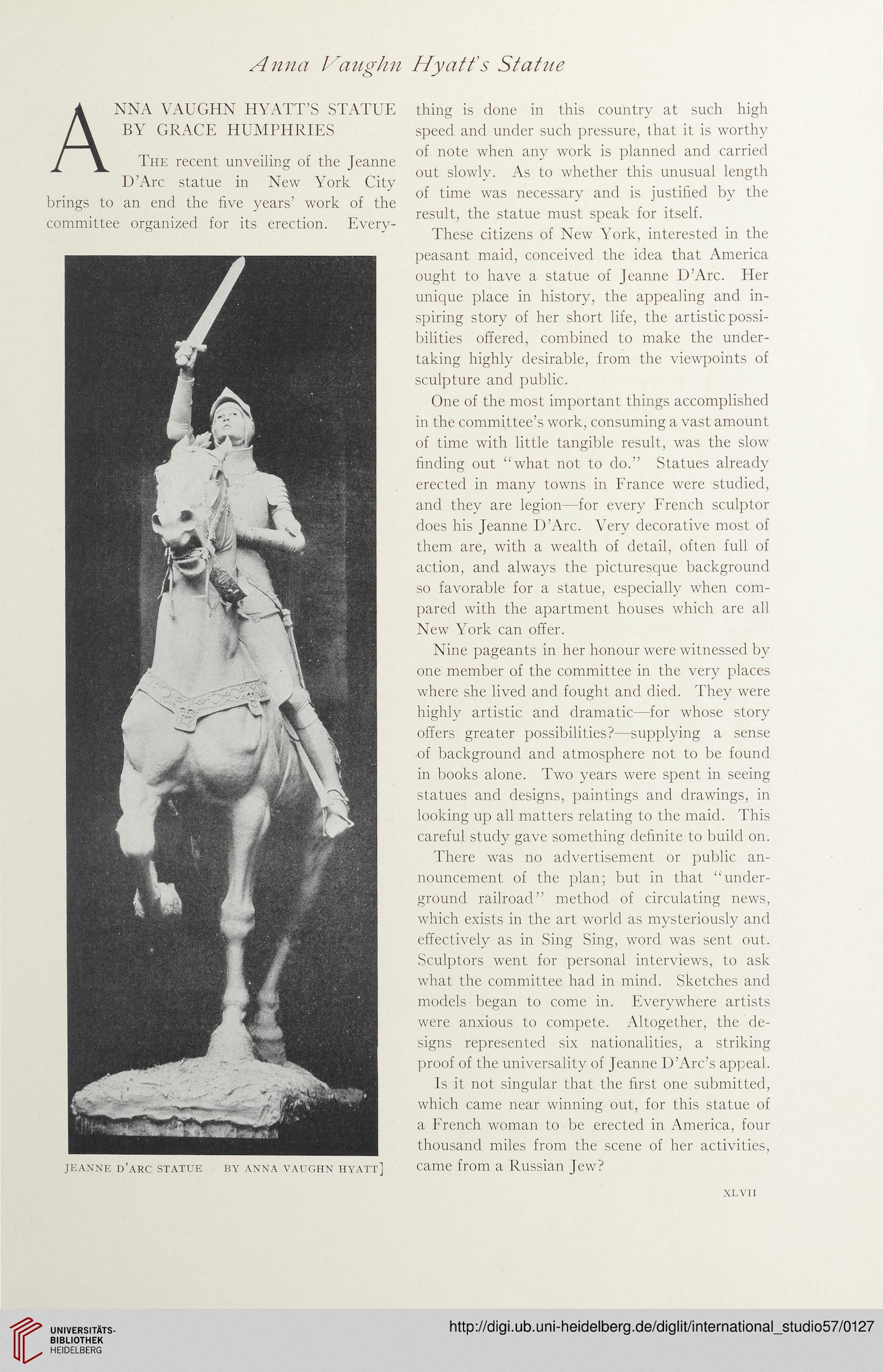Anna Haughn Hyatt's Statue
Anna vaughn hyatts statue
BY GRACE HUMPHRIES
The recent unveiling of the Jeanne
D’Arc statue in New York City
brings to an end the five years’ work of the
committee organized for its erection. Every-
JEANNE D’ARC STATUE BY ANNA VAUGHN HYATT]
thing is done in this country at such high
speed and under such pressure, that it is worthy
of note when any work is planned and carried
out slowly. As to whether this unusual length
of time was necessary and is justified by the
result, the statue must speak for itself.
These citizens of New York, interested in the
peasant maid, conceived the idea that America
ought to have a statue of Jeanne D’Arc. Her
unique place in history, the appealing and in-
spiring story of her short life, the artistic possi-
bilities offered, combined to make the under-
taking highly desirable, from the viewpoints of
sculpture and public.
One of the most important things accomplished
in the committee’s work, consuming a vast amount
of time with little tangible result, was the slow
finding out “what not to do.” Statues already
erected in many towns in France were studied,
and they are legion—for every French sculptor
does his Jeanne D’Arc. Very decorative most of
them are, with a wealth of detail, often full of
action, and always the picturesque background
so favorable for a statue, especially when com-
pared with the apartment houses which are all
New York can offer.
Nine pageants in her honour were witnessed by
one member of the committee in the very places
where she lived and fought and died. They were
highly artistic and dramatic—for whose story
offers greater possibilities?—supplying a sense
of background and atmosphere not to be found
in books alone. Two years were spent in seeing
statues and designs, paintings and drawings, in
looking up all matters relating to the maid. This
careful study gave something definite to build on.
There was no advertisement or public an-
nouncement of the plan; but in that “under-
ground railroad” method of circulating news,
which exists in the art world as mysteriously and
effectively as in Sing Sing, word was sent out.
Sculptors went for personal interviews, to ask
what the committee had in mind. Sketches and
models began to come in. Everywhere artists
were anxious to compete. Altogether, the de-
signs represented six nationalities, a striking
proof of the universality of Jeanne D’Arc’s appeal.
Is it not singular that the first one submitted,
which came near winning out, for this statue of
a French woman to be erected in America, four
thousand miles from the scene of her activities,
came from a Russian Jew?
XLVII
Anna vaughn hyatts statue
BY GRACE HUMPHRIES
The recent unveiling of the Jeanne
D’Arc statue in New York City
brings to an end the five years’ work of the
committee organized for its erection. Every-
JEANNE D’ARC STATUE BY ANNA VAUGHN HYATT]
thing is done in this country at such high
speed and under such pressure, that it is worthy
of note when any work is planned and carried
out slowly. As to whether this unusual length
of time was necessary and is justified by the
result, the statue must speak for itself.
These citizens of New York, interested in the
peasant maid, conceived the idea that America
ought to have a statue of Jeanne D’Arc. Her
unique place in history, the appealing and in-
spiring story of her short life, the artistic possi-
bilities offered, combined to make the under-
taking highly desirable, from the viewpoints of
sculpture and public.
One of the most important things accomplished
in the committee’s work, consuming a vast amount
of time with little tangible result, was the slow
finding out “what not to do.” Statues already
erected in many towns in France were studied,
and they are legion—for every French sculptor
does his Jeanne D’Arc. Very decorative most of
them are, with a wealth of detail, often full of
action, and always the picturesque background
so favorable for a statue, especially when com-
pared with the apartment houses which are all
New York can offer.
Nine pageants in her honour were witnessed by
one member of the committee in the very places
where she lived and fought and died. They were
highly artistic and dramatic—for whose story
offers greater possibilities?—supplying a sense
of background and atmosphere not to be found
in books alone. Two years were spent in seeing
statues and designs, paintings and drawings, in
looking up all matters relating to the maid. This
careful study gave something definite to build on.
There was no advertisement or public an-
nouncement of the plan; but in that “under-
ground railroad” method of circulating news,
which exists in the art world as mysteriously and
effectively as in Sing Sing, word was sent out.
Sculptors went for personal interviews, to ask
what the committee had in mind. Sketches and
models began to come in. Everywhere artists
were anxious to compete. Altogether, the de-
signs represented six nationalities, a striking
proof of the universality of Jeanne D’Arc’s appeal.
Is it not singular that the first one submitted,
which came near winning out, for this statue of
a French woman to be erected in America, four
thousand miles from the scene of her activities,
came from a Russian Jew?
XLVII




